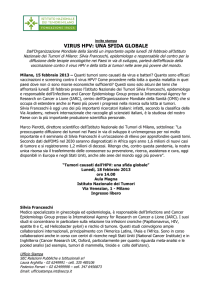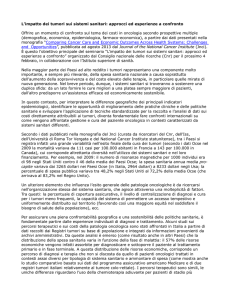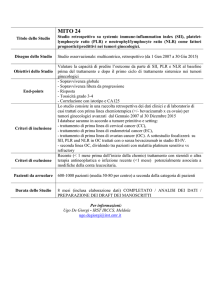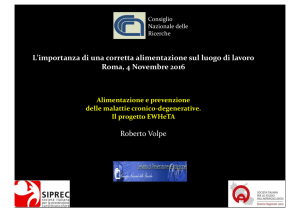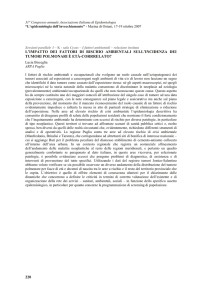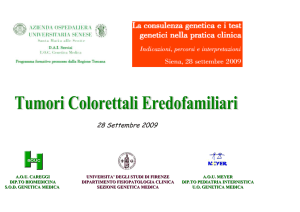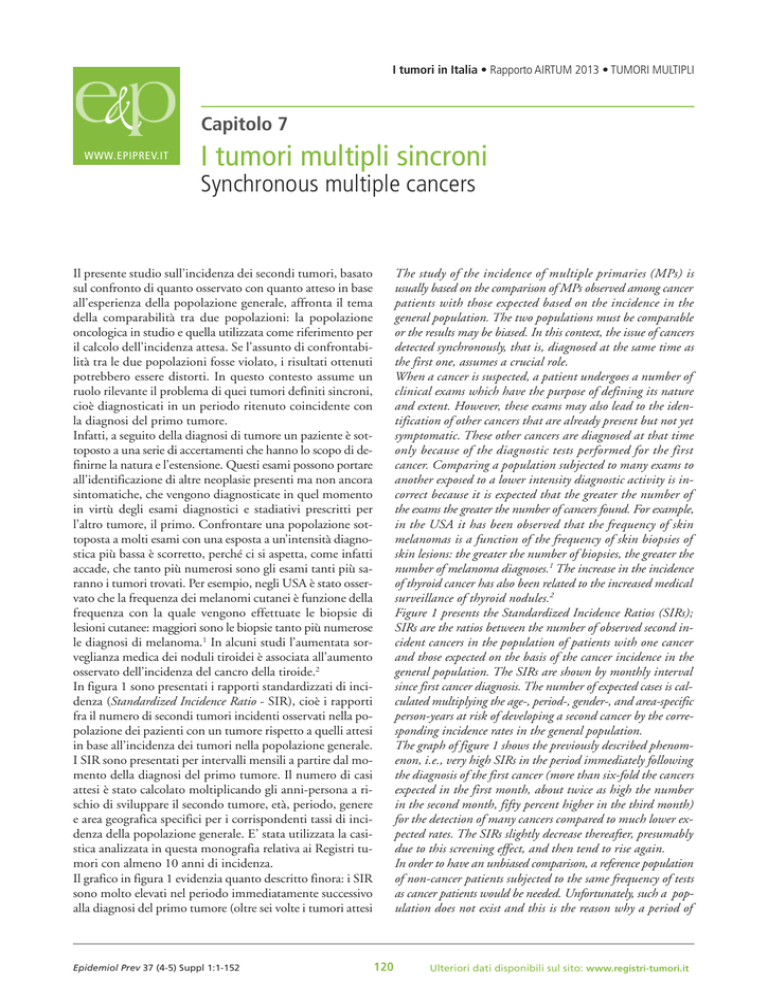
I tumori in Italia • Rapporto AIRTUM 2013 • TUMORI MULTIPLI
Capitolo 7
WWW.EPIPREV.IT
I tumori multipli sincroni
Synchronous multiple cancers
Il presente studio sull’incidenza dei secondi tumori, basato
sul confronto di quanto osservato con quanto atteso in base
all’esperienza della popolazione generale, affronta il tema
della comparabilità tra due popolazioni: la popolazione
oncologica in studio e quella utilizzata come riferimento per
il calcolo dell’incidenza attesa. Se l’assunto di confrontabilità tra le due popolazioni fosse violato, i risultati ottenuti
potrebbero essere distorti. In questo contesto assume un
ruolo rilevante il problema di quei tumori definiti sincroni,
cioè diagnosticati in un periodo ritenuto coincidente con
la diagnosi del primo tumore.
Infatti, a seguito della diagnosi di tumore un paziente è sottoposto a una serie di accertamenti che hanno lo scopo di definirne la natura e l’estensione. Questi esami possono portare
all’identificazione di altre neoplasie presenti ma non ancora
sintomatiche, che vengono diagnosticate in quel momento
in virtù degli esami diagnostici e stadiativi prescritti per
l’altro tumore, il primo. Confrontare una popolazione sottoposta a molti esami con una esposta a un’intensità diagnostica più bassa è scorretto, perché ci si aspetta, come infatti
accade, che tanto più numerosi sono gli esami tanti più saranno i tumori trovati. Per esempio, negli USA è stato osservato che la frequenza dei melanomi cutanei è funzione della
frequenza con la quale vengono effettuate le biopsie di
lesioni cutanee: maggiori sono le biopsie tanto più numerose
le diagnosi di melanoma.1 In alcuni studi l’aumentata sorveglianza medica dei noduli tiroidei è associata all’aumento
osservato dell’incidenza del cancro della tiroide.2
In figura 1 sono presentati i rapporti standardizzati di incidenza (Standardized Incidence Ratio - SIR), cioè i rapporti
fra il numero di secondi tumori incidenti osservati nella popolazione dei pazienti con un tumore rispetto a quelli attesi
in base all’incidenza dei tumori nella popolazione generale.
I SIR sono presentati per intervalli mensili a partire dal momento della diagnosi del primo tumore. Il numero di casi
attesi è stato calcolato moltiplicando gli anni-persona a rischio di sviluppare il secondo tumore, età, periodo, genere
e area geografica specifici per i corrispondenti tassi di incidenza della popolazione generale. E’ stata utilizzata la casistica analizzata in questa monografia relativa ai Registri tumori con almeno 10 anni di incidenza.
Il grafico in figura 1 evidenzia quanto descritto finora: i SIR
sono molto elevati nel periodo immediatamente successivo
alla diagnosi del primo tumore (oltre sei volte i tumori attesi
Epidemiol Prev 37 (4-5) Suppl 1:1-152
The study of the incidence of multiple primaries (MPs) is
usually based on the comparison of MPs observed among cancer
patients with those expected based on the incidence in the
general population. The two populations must be comparable
or the results may be biased. In this context, the issue of cancers
detected synchronously, that is, diagnosed at the same time as
the first one, assumes a crucial role.
When a cancer is suspected, a patient undergoes a number of
clinical exams which have the purpose of defining its nature
and extent. However, these exams may also lead to the identification of other cancers that are already present but not yet
symptomatic. These other cancers are diagnosed at that time
only because of the diagnostic tests performed for the first
cancer. Comparing a population subjected to many exams to
another exposed to a lower intensity diagnostic activity is incorrect because it is expected that the greater the number of
the exams the greater the number of cancers found. For example,
in the USA it has been observed that the frequency of skin
melanomas is a function of the frequency of skin biopsies of
skin lesions: the greater the number of biopsies, the greater the
number of melanoma diagnoses.1 The increase in the incidence
of thyroid cancer has also been related to the increased medical
surveillance of thyroid nodules.2
Figure 1 presents the Standardized Incidence Ratios (SIRs);
SIRs are the ratios between the number of observed second incident cancers in the population of patients with one cancer
and those expected on the basis of the cancer incidence in the
general population. The SIRs are shown by monthly interval
since first cancer diagnosis. The number of expected cases is calculated multiplying the age-, period-, gender-, and area-specific
person-years at risk of developing a second cancer by the corresponding incidence rates in the general population.
The graph of figure 1 shows the previously described phenomenon, i.e., very high SIRs in the period immediately following
the diagnosis of the first cancer (more than six-fold the cancers
expected in the first month, about twice as high the number
in the second month, fifty percent higher in the third month)
for the detection of many cancers compared to much lower expected rates. The SIRs slightly decrease thereafter, presumably
due to this screening effect, and then tend to rise again.
In order to have an unbiased comparison, a reference population
of non-cancer patients subjected to the same frequency of tests
as cancer patients would be needed. Unfortunately, such a population does not exist and this is the reason why a period of
120
➤ Ulteriori dati disponibili sul sito: www.registri-tumori.it
I tumori in Italia • Rapporto AIRTUM 2013 • TUMORI MULTIPLI
I tumori multipli sincroni
nel primo mese, circa due volte nel secondo mese, il 50% in
più nel terzo mese) per l’identificazione di molti tumori rispetto a un numero atteso di neoplasie inferiore. Successivamente i SIR si riducono, anche se in modo lieve, presumibilmente per l’effetto dello screening avvenuto nel periodo
di sincronicità, per poi tendere a risalire.
Perché il confronto fra le due popolazioni non risulti distorto,
sarebbe necessario avere una popolazione di riferimento non
oncologica ma sottoposta agli stessi esami. Questa popolazione non esiste: ecco il motivo per cui negli studi sull’incidenza di secondi tumori viene escluso un periodo di varia
lunghezza successivo alla data di diagnosi del primo tumore.
Il periodo di sincronicità è arbitrario e non ne esiste una definizione univoca. Gli studi che hanno affrontato la stima del
rischio di secondi tumori in casistiche di popolazione hanno
adottato periodi temporali diversi: 1 mese,3,4 2 mesi,5-11 3
mesi12,13 e 12 mesi.14-16 Inoltre vi sono studi che hanno
incluso nell’analisi tutti i tumori, sincroni e metacroni,17 e altri che hanno effettuato analisi con e senza esclusione.3
variable length following the date of diagnosis of the first cancer
is excluded in studies on MP incidence. The definition of the
period of synchronicity is arbitrary. The studies that have dealt
with population-based MP measures have adopted different
time periods: 1 month,3,4 2 months,5-11 3 months,12,13 and 12
months.14-16 Karahalios et al. have included in the analysis all
cancers, synchronous and metachronous,17 and other authors
have performed the analyses with and without the synchronous
cancers.3
WHAT IS THE EFFECT OF EXCLUDING OBSERVED AND
EXPECTED MPs IN THE PERIOD OF SYNCHRONICITY?
To answer this question, it is necessary to address several issues.
Exclusion of indolent cancers
Some of the synchronous cancers would never have been symptomatic in the lifetime of the patients, who would have remained unaware of the diseases, which are identified only because of the intense investigative activity related to the first
cancer. This phenomenon, well known in screening programmes
and early diagnosis activities, is defined as overdiagnosis.18
These types of cancers are also documented in autopsy studies, in
which unsuspected (and undiagnosed in life) cancers are diagnosed
post mortem.19,20 The example of cancers diagnosed post mortem
clarifies how a portion of cases may be diagnosed during life just because of clinical examinations performed with other ends.
That is, if the patient hadn’t been diagnosed with the first
cancer, there would not have been the initial onset of the symptoms for the second cancer and therefore the second cancer
would not have been diagnosed, and it would not had contributed to the incidence frequency.
The exclusion during the synchronous period of these indolent
tumours should therefore not have an effect on SIR estimates
and including them would result in an overestimation. For
this specific aspect, the exclusion of the period of synchronicity
produces more accurate estimates.
COSA HA DETERMINATO L’ESCLUSIONE DEI TUMORI
OSSERVATI E ATTESI NEL PERIODO DI SINCRONICITÀ?
Per poter rispondere a questa domanda è necessario considerare alcuni aspetti:
Esclusione di tumori indolenti
Una parte dei tumori sincroni non avrebbero mai dato segni
clinici nel corso della vita dei pazienti che avrebbero quindi
convissuto ignari con queste patologie, identificate solo a
causa dell’intensa attività investigativa legata al primo tumore. Questo fenomeno, particolarmente noto nel campo
degli screening e di tutte le attività di diagnosi precoce, è definito sovradiagnosi.18
La presenza di questa tipologia di tumori è documentata anche da studi autoptici che identificano la presenza di neoplasie mai sospettate né diagnosticate in vita in pazienti deceduti
per altra causa.19,20 L’esempio delle neoplasie diagnosticate post
mortem serve a chiarire che anche una parte di quelle diagnosticate in vita possono essere individuate solo per effetto
degli esami eseguiti con altra finalità: se non ci fosse stato il
primo tumore e l’iter diagnostico conseguente, i tumori indolenti non si sarebbero manifestati e quindi non avrebbero
contribuito all’incidenza. L’esclusione nel periodo di sincronicità di questi tumori indolenti non dovrebbe pertanto
avere effetto sulle stime dei SIR, mentre includerli causerebbe
una sovrastima. Per questo gruppo specifico, l’esclusione del
periodo di sincronicità produce stime più accurate.
Early diagnosis
The synchronous diagnosis of certain cancers anticipates their
natural onset by a few weeks, months, or years. This is the principle
on which screening is based: 21 to anticipate diagnosis to a stage in
which treatment is able to modify the prognosis, resulting in a reduction of cause-specific mortality. By excluding these cancers
because of their synchronous nature, the real risk of MP in the
population of cancer patients would be underestimated. The underestimation is certain, but its amount is not quantifiable.
To obtain an unbiased estimate of the incidence of second
cancers the first group (indolent cases) should be excluded from
the analysis and the second group (anticipated cases) should
be included. However, it is impossible to distinguish whether
a second synchronous cancer is overdiagnosed (i.e., one that
would never have been detected in the absence of investigative
Anticipazione diagnostica
La diagnosi sincrona di alcuni tumori anticipa di qualche settimana, mese o anno il loro normale decorso biologico che
li avrebbe resi sintomatici in tempi successivi. Questo è il
principio sul quale si basano gli screening,21 ovvero anticipare
Epidemiol Prev 37 (4-5) Suppl 1:1-152
121
➤ Ulteriori dati disponibili sul sito: www.registri-tumori.it
I tumori in Italia • Rapporto AIRTUM 2013 • TUMORI MULTIPLI
I tumori multipli sincroni
la diagnosi in una fase preclinica di malattia nella quale la terapia sia in grado di modificare la prognosi determinando una
riduzione della mortalità. Si tratta di tumori che si immagina
sarebbero comparsi nel corso della vita di quei soggetti come
secondi tumori. Escluderli perché diagnosticati in prossimità
della diagnosi del primo tumore sottostima il reale rischio di
secondi tumori nella popolazione dei pazienti oncologici. La
sottostima è certa, ma l’entità non è quantificabile.
activities related to the first cancer) or diagnosed early (diagnosed
at a time prior to when it would be clinically evident). All diagnosed cancers are treated, making it impossible to split the
natural history of the disease from the effect of treatment.
The length of the period of synchronicity
An underestimation of the risk of MP incidence is expected
after the period of synchronicity, due to the absence of cancers
whose diagnosis has been anticipated in the period of synchronicity. This underestimation is likely to be greater the longer
the period of synchronicity.
The aforementioned studies are not comparable, because they
may differ in other variables that can strongly influence the
number of cancers in a subject, as, for example, the definition
of MP.22
In the following table, the MP SIRs have been analyzed for
different synchronicity cut-offs for AIRTUM registries with at
least 10 years of activity (both genders together and all cancers
excluding skin epithelioma). If all the cancers are considered,
including synchronous ones, the average MP risk in the period
of follow-up is 23% (SIR: 1.23); if the first month after first
cancer diagnosis is excluded the risk is halved (SIR: 1.12 );
excluding the first three months, the number of second cancers
observed is 9% higher than the number expected (SIR: 1.09);
finally, excluding the first year, the second year, or the first 5
years the risk increases. What can be seen in the long run, or
after a few years, is a complex phenomenon that is influenced
by the absence of observed cases, because they are overdiagnosed
synchronously with the first cancer, but also influenced by the
expected deficit due to the anticipated diagnoses. Changes in
incidence may also be due to treatment and the diagnostic follow-up pressure, and also to the possible occurrence of other
cancers, related or unrelated to underlying genetic and environmental factors.
On the contrary, excluding the first months after first cancer
diagnosis affects mainly the cases related with early diagnosis
and over-diagnosis. The two-month period chosen by many
authors and also adopted in this monograph seems to absorb
the whole effect of the diagnostic phase.
Per ottenere una stima non distorta dell’incidenza dei secondi
tumori, si dovrebbe escludere dalle analisi il primo gruppo (tumori indolenti) e includere il secondo (pur tenendo conto
dello spostamento temporale della diagnosi). Tuttavia nella
pratica clinica è impossibile determinare se un secondo tumore
sincrono sia stato sovradiagnosticato (cioè se non sarebbe mai
stato individuato in assenza dell’attività investigativa legata al
primo tumore) o soltanto anticipato (quindi diagnosticato in
un momento antecedente a quello in cui si sarebbe comunque
manifestato clinicamente), poiché tutti i cancri diagnosticati
vengono trattati, rendendo impossibile distinguere la storia naturale della malattia dall’effetto del trattamento.
Lunghezza del periodo di sincronicità
E’ attesa una sottostima del rischio di incidenza di secondo tumore nei periodi successivi a quello di sincronicità, dovuta all’assenza dei tumori che non sono diagnosticati perché la
loro diagnosi è stata anticipata nel periodo di sincronicità, pertanto esclusi dall’analisi. Tale sottostima sarà presumibilmente
tanto maggiore quanto più esteso è il periodo di sincronicità.
Gli studi citati in precedenza non sono tutti confrontabili,
perché bisogna considerare anche altre variabili che possono
condizionare fortemente il numero di neoplasie in un soggetto, per esempio se siano adottate diverse definizioni per
i tumori multipli.22
In tabella 1, per i registri AIRTUM che avevano almeno 10
anni di attività è stato valutato il rischio complessivo di sviluppare un secondo tumore (esclusi osservati e attesi per la
medesima sede del primo tumore) in termini di SIR per entrambi i sessi assieme e per tutti i tumori (esclusi gli epiteliomi cutanei).
Se si considerano tutti i secondi tumori inclusi quelli sincroni il rischio medio nel periodo complessivo di follow-up
è del 23% (SIR: 1,23), se si esclude il primo mese questo rischio si dimezza (SIR: 1,12); se si escludono i primi tre mesi
il numero dei secondi tumori osservati è del 9% più elevato
del numero atteso (SIR: 1,09); escludendo il primo anno,
oppure il secondo o i primi 5 anni, il rischio risale. Quello
che si osserva nel lungo periodo, ovvero dopo alcuni anni,
è un fenomeno complesso che risulta influenzato dall’assenza
di casi sovradiagnosticati osservati in coincidenza con la
diagnosi del primo tumore, ma anche dal deficit atteso per
effetto dell’anticipazione diagnostica. Inoltre, altri fattori che
possono determinare variazioni nell’incidenza sono gli effetti
Epidemiol Prev 37 (4-5) Suppl 1:1-152
Length of follow-up
The exclusion of cancers whose diagnosis is anticipated will be
even more evident, with subsequent underestimated risk, when
the total period of the study is short. For example, if a cancer
registry had only two months of activity, considering this period
as synchronous, SIRs for MPs would be zero. If the period is
long or very long, the effect of the exclusion of synchronous
events, which is more evident in the months immediately following the diagnosis, will be diluted the more the time of diagnosis of the first cancer goes by, and the average risk will be
only marginally underestimated. In the present study, the time
of follow-up varies from registry to registry, from 3 to 32 years,
with an average follow-up of 14.2 years.
122
➤ Ulteriori dati disponibili sul sito: www.registri-tumori.it
I tumori in Italia • Rapporto AIRTUM 2013 • TUMORI MULTIPLI
I tumori multipli sincroni
7.0
legati alle terapie e all’attività di follow-up e al possibile manifestarsi di altri tumori legati a o indipendenti dalle caratteristiche genetico-ambientali dei soggetti interessati.
Al contrario, il “taglio” dei primi mesi si concentra prevalentemente sugli aspetti di diagnosi precoce e sovradiagnosi legati alla definizione del primo tumore. I due mesi, scelti da
molti autori e adottati anche in questa monografia, sembrano
assorbire tutto l’effetto della fase diagnostica.
OBSERVED/EXPECTED RATIO (SIR)
6.0
Lunghezza del periodo di follow-up
L’esclusione di tumori la cui diagnosi è anticipata sarà più
evidente, con riduzione del rischio, nei periodi successivi alla
diagnosi quando il periodo complessivo dello studio è breve.
Per assurdo, se un registro avesse solo due mesi di attività,
considerando questo periodo come sincrono, il SIR per i secondi tumori sarebbe nullo. Se il periodo è lungo o molto
lungo, l’effetto dell’esclusione di questi tumori, evidente nei
mesi immediatamente successivi, si diluirà tanto più ci si allontana dal momento della diagnosi del primo tumore e la
misura di rischio media complessiva sarà solo marginalmente
sottostimata. Nello studio presentato in questa monografia
il follow-up varia da registro a registro, da 3 a 32 anni, con
un follow-up teorico medio di 14,2 anni.
5.0
4.0
3.0
2.0
1.0
0.0
0
6
12
24
36
48
60
MONTHS SINCE DIAGNOSIS OF 1st CANCER
Figura 1. Pool AIRTUM: registri tumori con almeno 10 anni di incidenza disponibili
nella Banca dati AIRTUM. Rapporto standardizzato di incidenza fra secondi tumori
osservati e attesi (SIR), per tempo (mesi) dalla diagnosi del primo tumore.
Figure 1. AIRTUM Pool: cancer registries with at least 10 years of incidence
available in the AIRTUM Database. Standardized Incidence Ratio between
observed and expected second cancers (SIR) by number of months since the
diagnosis of the first cancer
CONCLUSIONS
To compute incidence, survival, and prevalence, cancer registries
use the same standards and rules,23,24 whereas for MP computations different methodological choices have been applied in
different studies, starting from the very definition of MP, as
discussed in chapter 6 (pp. 114-119).
In the present chapter, the effect of the exclusion of events (both
observed and expected cancers) over a period presumably coinciding with that of the diagnosis of the first cancer (period of
synchronicity) is discussed. This exclusion is justified by the need
to properly compare what has been observed with the data expected
in the general population. This period has an arbitrary length
and its exclusion or inclusion can lead to relevant effects.
The effect of this exclusion is confirmed to be an underestimation
of the risk of developing secondary cancers, which is greater the
more extended the period of exclusion and the shorter the total
period of the study.
In this monograph, it has been considered “synchronous”, in
agreement with the choice of the majority of similar studies in
the literature,5-11 a period of two months from the date of di-
CONCLUSIONI
A differenza degli indicatori di incidenza, sopravvivenza e prevalenza, per la determinazione dei quali i registri tumori adottano gli stessi standard e regole, per la stima dell’occorrenza dei
secondi tumori in studi diversi sono effettuate scelte metodologiche differenti, a partire dalla definizione stessa di “tumori
multipli”, come discusso al capitolo 6 (pp. 114-119).
E’ qui presentato l’effetto dell’esclusione degli eventi (tumori osservati e attesi) in un periodo presumibilmente
coincidente con quello della diagnosi del primo tumore (periodo di sincronicità). Tale esclusione è motivata dalla necessità di confrontare correttamente quanto osservato nella
popolazione generale con quanto atteso. Questo periodo ha
una lunghezza arbitraria e la sua esclusione o inclusione può
portare a effetti anche rilevanti.
Si conferma che l’effetto dell’esclusione sia una sottostima
del rischio di sviluppare secondi tumori, che diventa mag-
FOLLOW-UP PERIOD (MONTHS)
0+
1+
2+
3+
12+
24+
60+
O
O/E
O
O/E
O
O/E
O
O/E
O
O/E
O
O/E
O
O/E
94 424
1.23#
83 988
1.12#
80 989
1.10#
78 870
1.09#
68 159
1.11#
56 672
1.12#
32 303
1.14#
# p < 0.05
Tabella 1. Pool AIRTUM: Registri tumori con almeno 10 anni di incidenza disponibili nella Banca dati AIRTUM. Tutti i tumori maligni (esclusi i non melanomatosi della
cute) successivi a un primo tumore maligno (O): rapporto osservati/attesti (O/E) per periodo di follow-up.
Table 1. AIRTUM Pool: Cancer registries with at least 10 years of incidence available in the AIRTUM Database, all malignancies (excluding non-melanoma skin cancer)
subsequent to a first malignancy (O): ratio between observed/expected (O/E) cancers by period of follow-up.
Epidemiol Prev 37 (4-5) Suppl 1:1-152
123
➤ Ulteriori dati disponibili sul sito: www.registri-tumori.it
I tumori in Italia • Rapporto AIRTUM 2013 • TUMORI MULTIPLI
I tumori multipli sincroni
giore tanto più esteso è il periodo escluso e tanto più breve
è il periodo complessivo dello studio.
In questa monografia abbiamo considerato “sincroni”, in accordo con la scelta di maggioranza nella letteratura specifica,5-11 i tumori diagnosticati nei primi due mesi dalla diagnosi del primo, ma abbiamo anche scelto di presentare le
stime complessive includendo questi tumori che sovrastimano il rischio oncologico dei pazienti poiché conteggiano
anche una quota imprecisata di tumori indolenti; al contrario, la loro esclusione sottostima tale rischio per l’eliminazione di una quota di tumori aggressivi la cui diagnosi è stata
anticipata proprio in concomitanza della prima diagnosi.
Il rischio oncologico “vero” di pazienti già affetti da un tumore si collocherà fra le due stime, entrambe disponibili in
questa monografia.
agnosis of the first cancer, but the choose has been to present
the estimates that include the first two months. Their inclusion
overestimates the MP risk for the inclusion of indolent cancers,
their exclusion leads to an underestimation due to the elimination of a portion of aggressive cancers whose diagnosis was
anticipated to the period of first diagnosis.
The “true” MP risk for cancer patients will lie between the
two estimates, both of which are available in this monograph.
BIBLIOGRAFIA/REFERENCES
1. Welch HG, Woloshin S, Schwartz LM. Skin biopsy rates and incidence
of melanoma: population based ecological study. BMJ 2005;
331(7515):481.
2. Dal Maso L, Lise M, Zambon P et al; AIRTUM Working Group. Incidence of thyroid cancer in Italy, 1991-2005: time trends and age-period-cohort effects. Ann Oncol 2011;22(4):957-63.
3. Curtis RE, Boice JD Jr, Kleinerman RA, Flannery JT, Fraumeni JF Jr.
Summary: multiple primary cancers in Connecticut, 1935-82. Natl
Cancer Inst Monogr 1985;68:219-42.
4. Curtis RE, Freedman DM, Ron E et al (eds). New Malignancies Among
Cancer Survivors: SEER Cancer Registries, 1973-2000. NIH Publ No.
05-5302. Bethesda (MD), National Cancer Institute, 2006.
5. Storm HH, Jensen OM, Ewertz M et al. Summary: multiple primary
cancers in Denmark, 1943-80. Natl Cancer Inst Monogr 1985;
68:411-30.
6. Levi F, Randimbison L, Te VC, Rolland-Portal I, Franceschi S, La Vecchia
C. Multiple primary cancers in the Vaud Cancer Registry, Switzerland,
1974-89. Br J Cancer 1993;67(2):391-5.
7. Crocetti E, Buiatti E, Falini P; Italian Multiple Primary Cancer Working
Group. Multiple primary cancer incidence in Italy. Eur J Cancer
2001;37(18):2449-56.
8. Tsukuma H, Fujimoto I, Hanai A, Hiyama T, Kitagawa T, Kinoshita N.
Incidence of second primary cancers in Osaka residents, Japan, with
special reference to cumulative and relative risks. Jpn J Cancer Res
1994;85(4):339-45.
9. Tabuchi T, Ito Y, Ioka A, Miyashiro I, Tsukuma H. Incidence of
metachronous second primary cancers in Osaka, Japan: update of
analyses using population-based cancer registry data. Cancer Sci
2012;103(6):1111-20.
10.Teppo L, Pukkala E, Saxén E. Multiple cancer – an epidemiologic exercise in Finland. J Natl Cancer Inst 1985;75(2):207-17.
11.Coleman MP. Multiple primary malignant neoplasms in England and
Wales, 1971-1981. Yale J Biol Med 1986;59(5):517-31.
Epidemiol Prev 37 (4-5) Suppl 1:1-152
12.Karahalios E, English D, Thursfield V, Simpson J, Farrugia H, Giles G.
Second primary cancers in Victoria. Victorian Cancer Registry, Cancer
Epidemiology Centre, The Cancer Council of Victoria, Australia.
Melbourne 2009. Available at: http://www.cancervic.org.au/aboutour-research/epidemiology/second-primary-cancers-victoria
13.Curado MP, Edwards B, Shin HR et al. Cancer Incidence in Five Continents, Vol. IX. IARC Scientific Publication No. 160. Lyon, IARC, 2007.
14.Berrino F, Verdecchia A, Lutz JM, Lombardo C, Micheli A, Capocaccia
R; EUROCARE Working Group. Comparative cancer survival information in Europe. Eur J Cancer 2009,45(6):901-8.
15.Youlden DR, Baade PD. The relative risk of second primary cancers
in Queensland, Australia: a retrospective cohort study. BMC Cancer
2011;11:83.
16.Cluze C, Delafosse P, Seigneurin A, Colonna M. Incidence of second
cancer within 5 years of diagnosis of a breast, prostate or colorectal
cancer: a population-based study. Eur J Cancer Prev 2009;18(5):
343-8.
17.Heard A, Roder D, Luke C. Multiple primary cancers of separate organ
sites: implications for research and cancer control (Australia). Cancer
Causes Control 2005;16(5):475-81.
18.Puliti D, Duffy SW, Miccinesi G et al; EUROSCREEN Working Group.
Overdiagnosis in mammographic screening for breast cancer in Europe: a literature review. J Med Screen 2012;19 Suppl 1:42-56.
19.Breslow N, Chan CW, Dhom G et al. Latent carcinoma of prostate at
autopsy in seven areas. The International Agency for Research on
Cancer, Lyons, France. Int J Cancer 1977;20(5):680-8.
20.Sobrinho-Simôes MA, Sambade MC, Gonçalves V. Latent thyroid carcinoma at autopsy: a study from Oporto, Portugal. Cancer 1979;
43(5):1702-6.
21.Morrison AS. Screening in chronic disease. New York, Oxford University Press, 1992.
22.Crocetti E, Buiatti E. Re: multiple neoplasias: an oncologic reality.
J Natl Cancer Inst 1997;89(21):1634-6.
124
➤ Ulteriori dati disponibili sul sito: www.registri-tumori.it


